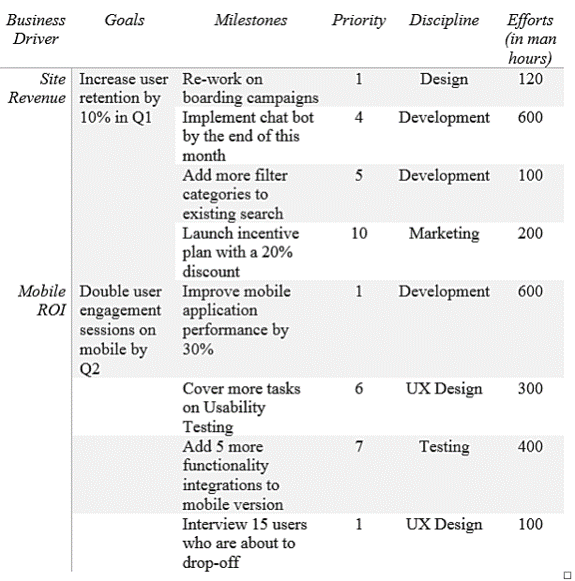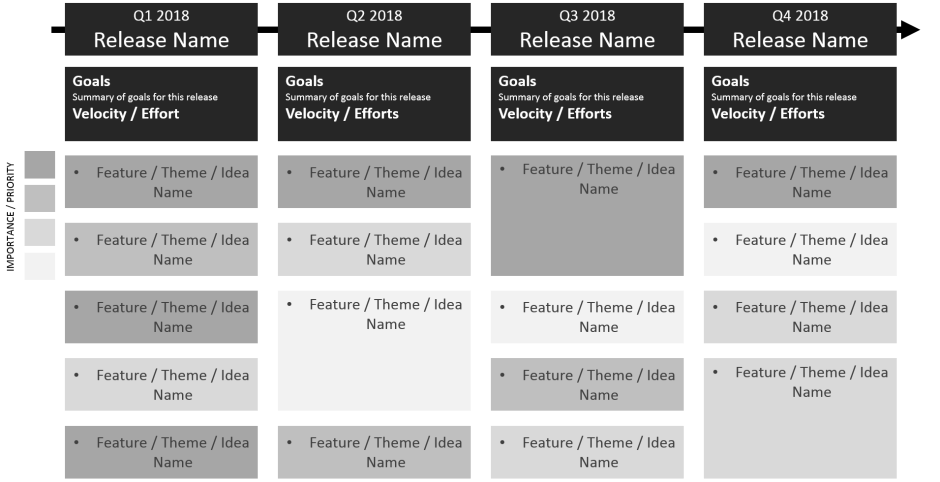“In preparing for battle I have always found that plans are useless, but planning is indispensable.”
― Dwight D. Eisenhower
Hope we have come across this quote quite a few times or at least reading it for the first time?
In this article, we will take a look at how to create a road map and discuss common problems that are overlooked in the industry for creating an evolving Road map. Before we do that let’s understand,
What is a product road map?
A road map is a plan that inspires stakeholders to illustrate vision, goals, boundaries, competition and product directions over a period of time. It contains a strategic plan for achieving the goals thorough KPIs and it is formatted for everyone to easily understand and get inspired.
When and why do we create a road map?
Road maps are good to create when you have done the envisioning for a new or existing product by understanding problems, end users and competitors through one or more research methods. You can gain insights by conducting stakeholder interviews with various stakeholders with-in the organization.
Why?
- Inspire stakeholders or customers with product release timelines to fulfill their expectations or demands.
- To strategically visualize outcomes based on a time period to determine boundaries and choose battles wisely.
- When there is a need to digitally transform and modernize portfolio.
- Constantly re-position products to stay ahead of the competition
- When there is a difference of understanding / views that exists within the team and alignment of organizational goals are needed across departments.
- Strategic new product development and plan market release
- To envision, predict, validate and plan for the best or worst times and business directions
When?
- There is good understanding of all the problems and end customer needs
- When you have envisioned and prioritized all the necessary themes / key features / requirements / problems and solutions
- When the project/product team has a good understanding of the competition involved.
- When you have collated all the business drivers and validated goals, business problems and relevant stakeholders/departments.
Who creates this?
A Road map can be created by anybody who might be involved in solving the above listed need. However, it is usually created by the product management team along with the help of various stakeholder from different departments like sales, Service, Marketing, Management, Development etc.
What are the different elements of a product road map?
- Overall timeline & Efforts
- Goals & Strategic Approaches
- Key releases and features that deliver on the goals
- Epics or Major features
- Key Users stories or features
- Discipline
- Dependencies
What are the steps involved in creating a road map?
Before we create a road map it is important to
- Understand the purpose/goals of the application
- Understand target users
- Understand Competitors
- Orchestration of the different services for the application
- Create New Ideas
- Solutions
All of these are covered as part of the User Research during Discovery Phase. However, in this article, I have covered ways to creating a road map before UX research is conducted. So, the steps would look something link the one below.

An example I want to quote is when I was a Product Designer for a tech engineering company in Dubai, every senior member of different departments had their own vision and goals for the new software product development. So, I did some learning though desk research from industry experts like Bruce McCarthy and various other experts and tried to combine my own.
The first logical step was to understand what each of the stakeholder’s perspectives and business drivers were through stakeholder interviews. Though, I had used the below mentioned protocol, it would be good to create a customized protocol by asking what really drives the business from a revenue and ROI perspective to define the product goals. The key to success of these sessions depend on how you probe further to understand the problem areas and expectations during the interviews.
- What is the purpose of the application?
- What are the goals of the application?
- How would you describe the application?
- From an organization’s viewpoint?
- From a user’s viewpoint?
- What would the users do with the application?
- What are the business drivers according to you?
- Who are our biggest competitors?
- Who are the customers/users?
- What user research have we already done that might be relevant for this project?
- Who do we want the customers/ users to be in 5 or 10 years?
- Do we know the primary use context for the product?
I tried to derive the goals, milestones and discipline from the business drivers by probing during the recorded stakeholder interview sessions that were conducted with a minimum of 3 and a maximum of 5 key participants from various departments within the organization.
You can refer What are business drivers? article from Corporate Finance Institute for an overview on how to understand what business drivers are. A few examples of the product goals include
- Increase revenue by 10% this year
- Ideate and ship features for premium subscribers
- Launch new integrations with 3rd party partners by mid of Q4
- Increase premium subscription signups by 2%
- Increase the current time on task by 3% by automation.
then I collated them on a spreadsheet and discussed their commitments based on the ideas or goals for which they are willing to contribute that year.

The ranking or the priority is based on the importance and time commitment towards their respective milestones. Now that we have the priority based on value points, we just have to calculate the efforts based on complexity score for each milestone. This method is also called top down estimation. I calculated the complexity based on different disciplines. Try to toggle values for each discipline based on definitive complexity by consulting with respective Leads from various teams like Development, Testing, Sales, Marketing Etc. The final values are based on man hours required, the respective discipline and complexity.
Design = (Low = 5hrs, Medium = 9hrs and High = 16hrs)
Development = (Low = 9hrs, Medium = 16hrs and High = 22hrs)
It is good to be pessimistic at the start and you might want to consider adding some buffer to the final score. I usually keep about 10% to 15% buffer for review or rework on top of the existing sum of efforts for each milestone.
The final Road map format should look something like the one below (figure 2)
- It should have a clear Release Name without exact dates
- List of goals or summary of goals for that release
- Velocity/Efforts required for that release
- Clear list of all deliverable like themes/Key features/Ideas indicated based on the priority, thorough colors. This should be understandable and be written in a simple language that can be understood by all the relevant stakeholder and customers

Please feel free to get creative and experiment with the visualization here.
Conclusion
While this could be a shortcut to creating a road map. I found that I had overlooked at a lot of things by keeping the process short. For instance,
- Understanding the purpose/goals of the application
- Understanding target users
- Understanding Competitors
- Orchestration of the different services to envision the users journey based on Current, Near future and Future
- New Ideas
- Solutions
But, its ok to keep it simple at the start as UX research requires time & effort. It is also important not to spend too much time estimating and analyzing the efforts for each mile stone. I will detail out the second approach of how we uncover the requirements over a separate post.
References
https://corporatefinanceinstitute.com/resources/knowledge/modeling/business-drivers/
The Dirty Dozen Road map Road blocks by Bruce McCarthy
